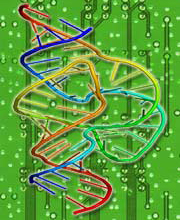Scientists in California have created molecular computers that are able to self-assemble out of strips of RNA within living cells. Eventually, such computers could be programmed to manipulate biological functions within the cell, executing different tasks under different conditions. One application could be smart drug delivery systems, says Christina Smolke, who carried out the research with Maung Nyan Win and whose results are published in the latest issue of Science.
The use of biomolecules to perform computations was first demonstrated by the University of Southern California's Leonard Adleman in 1994, and the approach was later developed by Ehud Shapiro of the Weizmann Institute of Science, in Rehovot, Israel. But according to Shapiro, "What this new work shows for the first time is the ability to detect the presence or absence of molecules within the cell."
That opens up the possibility of computing devices that can respond to specific conditions within the cell, he says. For example, it may be possible to develop drug delivery systems that target cancer cells from within by sensing genes used to regulate cell growth and death. "You can program it to release the drug when the conditions are just right, at the right time and in the right place," Shapiro says.
Smolke and Win's biocomputers are built from three main components--sensors, actuators, and transmitters--all of which are made up of RNA. The input sensors are made from aptamers, RNA molecules that behave a bit like antibodies, binding tightly to specific targets. Similarly, the output components, or actuators, are made of ribozymes, complex RNA molecules that have catalytic properties similar to those of enzymes. These two components are joined by yet another RNA molecule that serves as a transmitter, which is activated when a sensor molecule recognizes an input chemical and, in turn, triggers an actuator molecule.
Smolke and Win designed their RNA computers to detect the drugs tetracycline and theophylline within yeast cells, producing a fluorescent protein as an output. By combining the RNA components in certain ways, the researchers showed that they can get them to behave like different types of logic gates--circuit elements common to any computer. For example, an AND gate produces an output only when its inputs detect the presence of both drugs, while a NOR gate produces an output only when neither drug is detected.
But this is just a demonstration, Smolke says. "We're using these modular molecules that have a sort of plug-and-play capability," she says--meaning that they can be combined in a number of different ways. Different kinds of aptamers could potentially detect thousands of different metabolic or protein inputs.
Smolke and Win produce their device by encoding RNA sequences into DNA and introducing it into the cell. "So the cell is making these devices," Smolke says. "RNA is actually a very programmable substrate."
Indeed, the attractive thing about this approach is that the components of the device and the substrate holding them together are all made from RNA, says Friedrich Simmel, a bioelectronics researcher at the Technical University of Munich, in Germany. "This is something that we also would like to do," he says, for not only do such devices self-assemble, but they can also be produced on a single long strand of RNA, all at once.
Smolke and Win have already found collaborators for possible animal studies, to see how biocomputers can be delivered to cells and used once they're there. Smolke also envisions a large-scale collaboration to create a huge library of sensors out of which these devices can be made.
Copyright Technology Review 2008.

